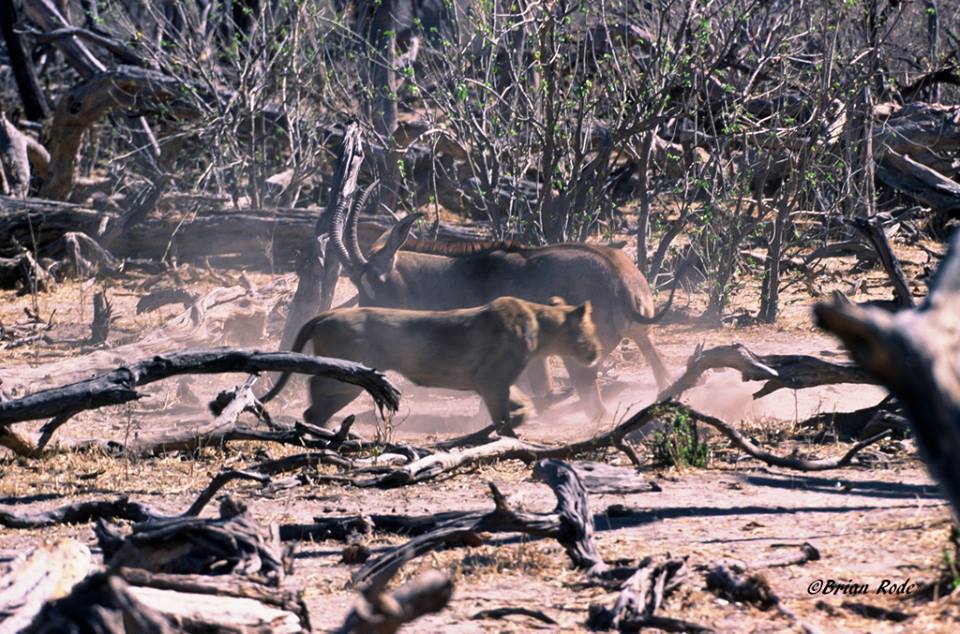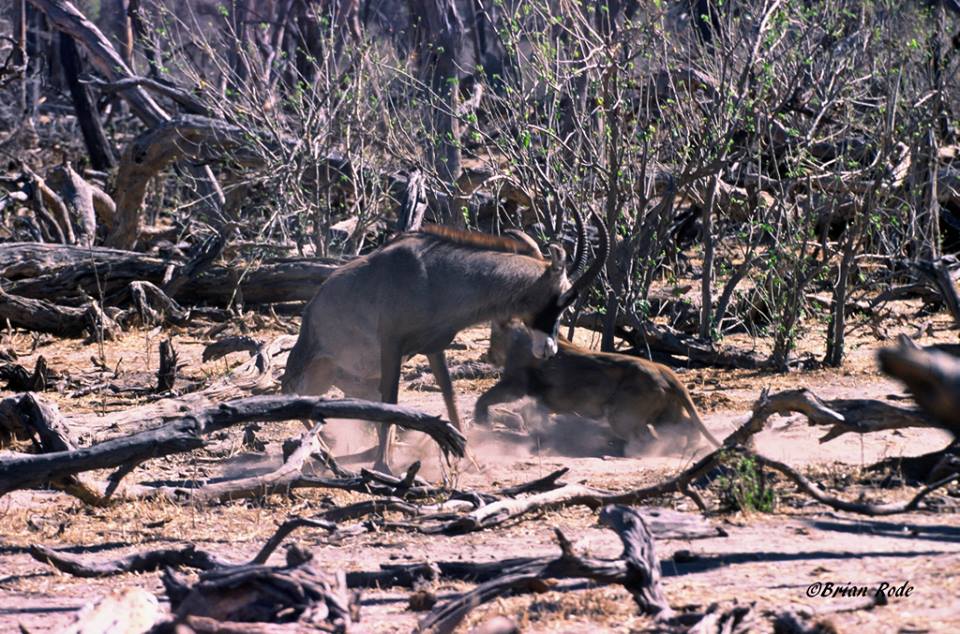Lion vs Roan antelope…an epic battle to the death! – story and images by Brian Rode
It was in the winter of 2003 and the Linyanti area was experiencing a severe drought….

The Savuti Channel was dry and formed a thin grassland snaking its way from the dry Savuti Marsh to the source at Zibadianja Lagoon, on the edge of the great geological fault line that separates the Linyanti Swamps of the Caprivi Strip and the dry mopane woodlands of Northern Botswana. Chantelle and I had come to this area to run, and guide from, a small, rustic camp called Linyanti Tented Camp (LTC). It was an amazing time! The nearest camp to us was Kings Pool, more than an hour and a half by vehicle, if you were early enough to avoid the elephants that came down to the Linyanti River in their hundreds to drink and bathe during the hotter hours and into the afternoon. An afternoon one-way trip always took a few hours just due to the numbers of elephants and other game in the way. It was amazing. Buffalos came in their massive herds to drink at the river and zebras, giraffes, kudus and many other antelope species also crossed the dry, dusty floodplains to get to get to the water. The Riparian Woodland above the faultline was almost bare of leaves and the grass had long ago been eaten or crushed as more and more animals came down to the Linyanti River for the life-giving water. Elephants had pushed mature mopane trees down all over the place, and the dead branches and trunks littered the woodland floor like gravestones in a cemetery. There was very little in the way of food near the river for the animals as it had all been eaten earlier on in the season and they had to travel daily from deep in the woodlands, across the barren floodplain, to the river and back again. Because of the drought we were seeing some of the more shy antelope like Sitatunga (in the elephant-flattened papyrus swamps of Caprivi), and also Roan and Sable Antelopes from deeper in the mopane woodlands, coming out into the open during the heat of the day. Both Roan and Sable are regal-looking large antelope from the Hippotragus (horse-antelope) Tribe and they are both truly majestic. The Sable Antelope is possibly the most stunning antelope in the world, with its long scythe-like horns curving over its boldly marked black back and white belly. The Roan is similar except that it has a light brown coloration (instead of black) and the horns are not as large as those of the Sable. Both have the characteristic pied, patterned faces, alternating black and white markings. The Roan Antelope is a stunning, impressive antelope and is difficult to see in Southern Africa, making it a lucky sighting, and good omen, if found.

Chantelle and I were driving from Kings Pool back to LTC, along the main path through the woodlands, transporting luggage for a group of guests and their guide, Richard. He would take a slower drive along the floodplains, do some game-viewing and then follow us to the camp, where their luggage would already be in their rooms/tents and they could await a warm, hearty meal and an ice- cold drink at the bar. We had specifically taken the main road so as to diminish the possibility that we get delayed by elephant herds blocking the path as the majority of them would be at the water already. As we came around a corner in the road we both spotted a Roan Antelope in amongst the fallen tree-trunks on our to the left hand side. It was lying down amongst the large branches and was giving alarm calls. When it tried to get up both Chantelle and I could see that it was really struggling to do so. We then saw that one of its hind back legs was broken and was just hanging by the skin and sinews. The antelope must have been in extreme pain. As we realised this we spotted a lioness crossing the road ahead of us going towards the Roan. We surmised that the lioness had already earlier attacked the antelope, who broke its leg trapping it in the mish-mash of fallen tree-trunks as it tried to escape the claws of the large tawny cat. The lioness had now returned to the Roan to finish it off. The feline at first kept her distance, wary of the horns, but then started circling the poor antelope. It struggled to turn with its broken back leg, but as the cat came closer the Roan kneeled down on its front legs and thrashed with its horns and the lioness retreated. The lioness tried a few times more, each time retreating from the waving weapons of the antelope and then decided to go and lie in the shade nearby and watch the Roan for a while, knowing that it would eventually weaken. As the cat moved off the roan lay down, constantly giving alarm snorts and watching all around it. It got more and more exhausted lying in the heat of the full sun, unable to move. At one point the Roan looked like it was falling asleep and the lioness decided to approach again. The Roan was certainly exhausted and yet it was still vigilant for as the tawny coloured enemy came closer the antelope kneeled up and thrashed its dangerous curved weapons at the lioness again.
We had watched this encounter between predator and prey for over an hour and we really needed to get back to camp, which was still a long drive away. We left the roan lying in the heat with a broken leg and a certainty that it was going to die. Yet it never gave up, facing off the lioness each time she approached. It was amazing to see the intense drive to survive and the power of determination of the antelope. We later heard from Richard that just after dark the lioness and the Roan Antelope were still stuck in their stale-mate, when a pride of lions started roaring a short way from them. The roaring got louder and louder and soon the lions found the lioness and the Roan still engaged in their ”cold-war” and the majestic antelope was finally given relief.





